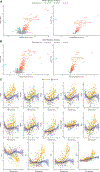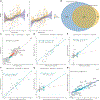CSF proteomics identifies early changes in autosomal dominant Alzheimer's disease
- PMID: 39332414
- PMCID: PMC11531390
- DOI: 10.1016/j.cell.2024.08.049
CSF proteomics identifies early changes in autosomal dominant Alzheimer's disease
Abstract
In this high-throughput proteomic study of autosomal dominant Alzheimer's disease (ADAD), we sought to identify early biomarkers in cerebrospinal fluid (CSF) for disease monitoring and treatment strategies. We examined CSF proteins in 286 mutation carriers (MCs) and 177 non-carriers (NCs). The developed multi-layer regression model distinguished proteins with different pseudo-trajectories between these groups. We validated our findings with independent ADAD as well as sporadic AD datasets and employed machine learning to develop and validate predictive models. Our study identified 137 proteins with distinct trajectories between MCs and NCs, including eight that changed before traditional AD biomarkers. These proteins are grouped into three stages: early stage (stress response, glutamate metabolism, neuron mitochondrial damage), middle stage (neuronal death, apoptosis), and late presymptomatic stage (microglial changes, cell communication). The predictive model revealed a six-protein subset that more effectively differentiated MCs from NCs, compared with conventional biomarkers.
Keywords: Somascan; autosomal dominant Alzheimer’s disease; microglia; mitochondrial damage; neurodegeneration; neuronal death; proteomics; pseudotrajectory analysis.
Copyright © 2024 The Author(s). Published by Elsevier Inc. All rights reserved.
Conflict of interest statement
Declaration of interests C.C. has received research support from GSK and EISAI. C.C. is a member of the advisory board of Circular Genomics and owns stocks in these companies. C.C. is on the advisory board of ADmit. J.L. reports speaker fees from Bayer Vital, Biogen, EISAI, TEVA, Zambon, Merck, and Roche; consulting fees from Axon Neuroscience, EISAI, and Biogen; author fees from Thieme medical publishers and W. Kohlhammer GmbH medical publishers; and is inventor in a patent “Oral Phenylbutyrate for Treatment of Human 4-Repeat Tauopathies” (EP 23 156 122.6). He receives compensation for serving as chief medical officer for MODAG GmbH and is a beneficiary of the phantom share program of MODAG GmbH. E.M. reports research support received from NIA (U01AG059798), Anonymous Foundation, GHR, Alzheimer Association, Eli Lilly Eisai, and Hoffmann-La Roche and paid consulting for Eli Lilly, Alector, Alzamend, Sanofi, AstraZeneca, Hoffmann-La Roche, Grifols, and Merck.
Figures






References
-
- Tang M, Ryman DC, McDade E, Jasielec MS, Buckles VD, Cairns NJ, Fagan AM, Goate A, Marcus DS, Xiong C, et al. (2016). Neurological manifestations of autosomal dominant familial Alzheimer’s disease: a comparison of the published literature with the Dominantly Inherited Alzheimer Network observational study (DIAN-OBS). Lancet Neurol 15, 1317–1325. 10.1016/S1474-4422(16)30229-0. - DOI - PMC - PubMed
MeSH terms
Substances
Grants and funding
- RF1 AG071706/AG/NIA NIH HHS/United States
- R01 AG058501/AG/NIA NIH HHS/United States
- RF1 AG083744/AG/NIA NIH HHS/United States
- RF1 AG053303/AG/NIA NIH HHS/United States
- RF1 AG058501/AG/NIA NIH HHS/United States
- K01 AG080123/AG/NIA NIH HHS/United States
- RF1 AG074007/AG/NIA NIH HHS/United States
- RF1 AG044546/AG/NIA NIH HHS/United States
- P30 AG066514/AG/NIA NIH HHS/United States
- U19 AG032438/AG/NIA NIH HHS/United States
- U01 AG058922/AG/NIA NIH HHS/United States
- R01 AG044546/AG/NIA NIH HHS/United States
- R01 AG078964/AG/NIA NIH HHS/United States
- P01 AG003991/AG/NIA NIH HHS/United States
- U01 AG059798/AG/NIA NIH HHS/United States
LinkOut - more resources
Full Text Sources
Medical

